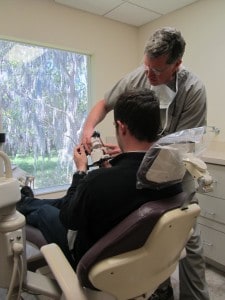Occlusion | Bite Problems
Taking a Bite Out of Explaining Your Bite
Occlusion & Malocclusion
What is Occlusion?
The way your teeth fit together is called Occlusion. Ideal dental occlusion is when the upper and lower teeth fit together in a comfortable relationship and there is no need for the jaw to reposition itself.
What is Malocclusion?
When your teeth are not in proper relation to each other and to your jaw joints, the jaw automatically shifts to a new position in an attempt to compensate for the misalignment of your teeth – a condition known as malocclusion. In other words, malocclusion exists when the lower jaw must shift in order to achieve functional closure. This jaw shift to reposition the teeth and attain closure is achieved at the expense of pressure points on the teeth themselves, and the supporting structures of the stomatognathic* system. This can be likened to a car with a front-end that is “out of alignment”.
*Stomatognathic (sto ma to na thik) – The masticatory (chewing) apparatus viewed as an entire system of function (including teeth, lips, tongue, muscles, TMJ’s, gums, bones, and nerves).
What are the Warning Signs of Malocclusion?
Warning signs of malocclusion include: gradual wearing away of tooth structure, tooth fracture, gum recession, loss of jaw bone support around the teeth and abfraction*, clicking and/or popping in the jaw joint, frequent headaches, face, head, neck, shoulder and back pain, dizziness and earaches.
*Abfraction (ab frak shun) – A peculiar “notch-like” lesion that forms on teeth, usually at the gum line due to tooth flexure associated with stressful clenching and grinding.
These warning signs are often either overlooked or thought to be unimportant because they progress gradually over time so as not to excite alarm, and many times are not uncomfortable in the early stages. If left untreated, however, the ravages of this occlusal disease can be devastating for those who value their teeth and want to keep them for a lifetime.

Diagnosing the Malocclusion Problem
Patients are accustomed to going to the dentist and being examined for the presence of cavities and gum disease. It is necessary for dental health that an evaluation of the occlusion (bite) be included in routine dental exams.
In malocclusion, the normal forces that are generated by the muscles that move the jaws can become destructive forces when the system is not in harmony. In other words, when the system isn’t working properly, the parts wear out quicker. The good news is that these forces can be brought under management so that they are no longer destructive. This requires first a thorough diagnosis of the underlying problem. When a malocclusion problem is found, a mounted study case of how the jaw joints guide the teeth to closure without interference from muscles and learned reflexes is needed. The study is accomplished by making molds of the mouth, taking patient measurements and constructing stone models to be mounted on a jaw simulator, called an articulator, so the malocclusion can be analyzed in detail.
Treating Malocclusion
After diagnosing the malocclusion problem, your dentist may recommend a variety of treatment options depending on the outcome of the mounted study.
Splint Appliances (Orthotic Appliance). Splint appliances are used for diagnostic and therapeutic treatment to eliminate bite disharmony and resulting symptoms. This initial treatment is often used to provide patient comfort and stability prior to definitive treatment.
Occlusal Equilibration. The surface of the teeth are recontoured, or reshaped to alleviate improper pressure points on individual teeth. This process will allow the teeth to mesh properly in relationship with the jaw joints and to hit with equal pressure and intensity in locations where they should contact. This equilibration has been found to be the solution for many of the warning signs associated with malocclusion and TMJ discomfort.
Occlusal Restoration. This option involves the replacement or reconstruction of teeth using fillings, crowns, bridges, implants and partial dentures.
Orthodontics. Sometimes the malocclusion is so great and the teeth are so far out of position that the only way to correct the problem properly is through orthodontic treatment. Frequently, the Invisalign method of clear aligners is suggested and used successfully.
For additional information regarding Malocclusion, please read the article: Malocclusion, An In-Depth Discussion presented below.

